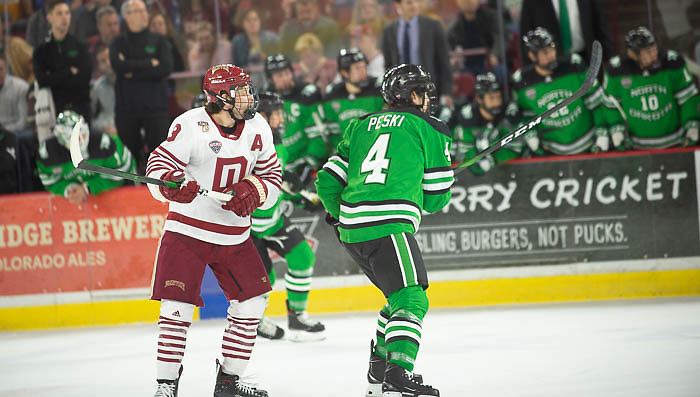
Each week during the season, we look at the big events and big games around Division I men’s college hockey in Tuesday Morning Quarterback.
Paula: It’s surprising that there’s so much to talk about this week, Jimmy, given how light the weekend’s schedule was, but there are a few things that jump out at me immediately.
The first is the tutorial that North Dakota is giving on how to finish up a first half strongly. The Fighting Hawks take a 13-game (12-0-1) unbeaten streak into the second half of the season having swept Western Michigan on the road two weekends ago.
In that 13-game stretch, North Dakota has averaged a little over four goals per game while keeping opponents to 1.25 goals per game on average, having allowed more than two goals in that span just twice. The Fighting Hawks have three overtime wins in those 13 games and an overtime tie with the extra point.
With Minnesota State’s loss to Northern Michigan Saturday – breaking the Mavericks’ 10-game win streak – the poll voters put North Dakota No. 1 in the nation. But the Mavericks and Cornell still received votes for first place.
Looking at the variety of ways that North Dakota has been able to find success in this first-half streak, the Fighting Hawks’ break until Jan. 3 and the strength of North Dakota’s remaining NCHC schedule, is it fair to say that the Fighting Hawks may be setting the tone for the rest of college hockey in the second half, a team that seems to control its own destiny from now until April?
Jim: North Dakota is as strong as we have seen in the last three seasons, and that’s no exaggeration.
This team has plenty of offense and defensively they can stymie teams. They certainly know how to win in different ways. In close games, they battle. But they also see the jugular and know how to blow away a team.
If anything could plague North Dakota in the regular season, it is the strength of opponents they will face in the NCHC. But one of our fellow college hockey writers, Brad Schlossman, had an interesting stat on Monday via Twitter:
Weeks at No. 1 (last six seasons)
84 – NCHC
15 – Big Ten
13 – Hockey East
11 – WCHA
10 – ECAC
… NCHC fans, you're spoiled (UND 22, SCSU 22, DU 21, UMD 19 have all individually spent more time at No. 1 than any entire conference outside the NCHC in that span).— Brad Elliott Schlossman (@SchlossmanGF) December 16, 2019
Seriously? There are four NCHC teams that collectively have spent more time in the last six seasons at No. 1 in the USCHO.com poll that ANY OTHER CONFERENCE COMBINED.
When I read that, I made me shake my head. But it also shows that no matter how difficult the NCHC play will be, qualify for the NCAA tournament from that conference and you likely have a chance to win a title.
Paula: That is an astounding statistic and the current reality of college hockey: Anyone who wants to win a national championship is going to have to go through an NCHC team in the playoffs, and most likely at the Frozen Four.
The last four consecutive national championships have gone to three NCHC teams, and since its inception, the NCHC has placed two teams in the Frozen Four field all but one year – and that was in 2018 when the Big Ten had three of the four teams in the field and Minnesota Duluth won it all.
I was thinking about exactly what you said, Jimmy, when looking at North Dakota’s remaining schedule. The only thing that may hamper the Fighting Hawks is their second-half schedule against conference opponents. For all of what we’ve said about the NCHC – and it doesn’t look any “weaker” than it has in past years – there are only three teams from the conference among the top 14 in the PairWise Rankings: North Dakota, Denver and Minnesota Duluth.
Look at the way strength of schedule works at the other end of the spectrum, with Atlantic Hockey. You and I have talked about how competitive this league has become, but its relative strength has given it no representation in the top spot and gives it very little representation in the poll on a regular basis. Yet the top two teams in the conference, Army and Sacred Heart, each have 10 conference wins. Army has 12 overall and Sacred Heart has 11 and both are knocking on the door of the top 16 in the PWR – and each has little chance for significant upward mobility because of the remaining conference schedule.
Having said that, though, we know that each – and maybe a couple of other teams from that league, like RIT and AIC – is someone capable of advancing in the NCAA tournament.
Jim: My concept on Atlantic Hockey’s NCAA at-large berth opportunities – when your nonconference record doesn’t top .400, understand that getting two teams in the NCAA tournament depends on a somewhat perfect scenario.
One team needs to run away with the conference – right now Army or Sacred Heart could possibly do that – but then lose the conference championship. We remember when Niagara did it back in 2012. But that has become increasingly difficult with the bottom of the league becoming stronger and thus running the table (or at least coming very close) on conference play is becoming near impossible.
I would, though, love to see an Atlantic team move up the PairWise and then earn the autobid, maybe as a No. 3 seed, or in an extreme case, a No. 2 seed. Listen, the narrative of the Atlantic Hockey champion winning the famous 16 versus 1 battle three times in five years is awesome. But I’d rather see an Atlantic Hockey team enter the tournament knowing they have a legitimate chance at reaching a Frozen Four.
Paula: Same here. I’m always delighted when we see significant progress in conferences that traditionally haven’t been strong or in conferences that go through much more of a waxing and waning process.
Watching Minnesota State as its 10-game win streak progressed had me watching the rest of the WCHA very carefully as well. Until the Mavericks’ loss to Northern Michigan this past weekend, Minnesota State had enjoyed five weeks at No. 1 in the USCHO Poll. That’s five of the eleven weeks that a WCHA has enjoyed in the top spot in the last six years, which puts so much into perspective where both Minnesota State and the WCHA are concerned.
It was Northern Michigan that finally ended that streak for Minnesota State, a 4-1 win for the Wildcats Saturday night. It was only the fourth time this season that Northern Michigan limited an opponent to one goal or less, and it was the only time this season that Mavericks failed to score more than one goal.
As good as Minnesota State is, the Mavericks have a few teams behind them in the WCHA that can threaten for a regular-season championship, including Bemidji State, which had its own six-game unbeaten streak broken Dec. 7 against Alaska. Also in the mix are Alaska, Bowling Green, Michigan Tech and maybe even Northern Michigan. As odd as this sounds, the Mavericks may be facing the same challenge in the second half of the season as are the Fighting Hawks: a league that is competitive deep enough to thwart a run for the title.
Jim: I don’t think that the WCHA has the exact same depth as the NCHC, but the top 4-5 teams in that league are always dangerous, making the WCHA very similar to the current day Atlantic Hockey.
We are truly close to the halfway point, and though our column will publish next week and really take a retrospective look at the first half, looking back on from early October until now, we’ve seen some great hockey.
I’m not exactly sure what stands out – we’ll talk more about that next week – but looking at the PairWise with teams like Notre Dame, Michigan State and Harvard all on the outside looking it and others like Clarkson, Arizona State and Bowling Green above the current cut line, there are a lot of interesting scenarios to play out.
And I look forward to each and every one!


